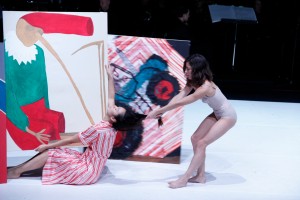In September 2011 Anne Juren and Roland Rauschmeier wrote the following text regarding their experience within the modul-dance project. They have developed the project entitled Tableaux Vivants, where the art forms interweave and allow hybrid relations to develop between the paintings, sculptures and videos and the bodies of the performers.
Within the frame of the modul-dance project, we worked in three different locations (Faro/Portugal, Poznań/Poland and Ljubljana/Slovenia) on the conceptualisation, ideal configuration and technical translation of our idea for Tableaux Vivants.
During our stay in Faro, the composer Johannes Maria Staud gave us a compilation of his works based on the suite Berenice so that we could take some initial decisions on the choice of music. We also developed a comprehensive mind map that included socio-historic facts, artists and relevant eras for our performance. The southern atmosphere and some very pleasant and spacious studios made Faro an ideal place to work and make an in-depth study of concepts and ideas in a relaxed way.
In Poznań we analysed our artistic stance in the context of plastic and performance arts so that we could establish the underlying structure of the piece. We decided to develop five thematic groups on Europe’s cultural development, using an approach that spanned several, bringing them together in terms of space and performance set-up.
To do so, we stuck to the time sequence of the themes, starting with the wall paintings of Lascaux caves and moving on to the origins of central perspective in the Renaissance and the optimistic abundance of the Baroque. In the fourth part of our artistic research we hit upon the idea of reinterpreting the Oskar Schlemmer and Bauhaus Triadic ballet. The last part tackles the problems of giving today’s artistic output validity and meaning in relation to the media cannons and their inherent evaluation. The choice of each cultural era is tied to personal experiences, such as a trip to Lascaux or extensive research into the influence that Bauhaus has had on the artistic development of Juren and Rauschmeier.
In Ljubljana, during a relatively initial stage of the project’s conception, we were able to work on the lighting for the definitive performance. This allowed us to dedicate more time to experiment with the inclusion of several media and genres with our performers.
We also made the final musical selection, by this point Staud had already made four versions. We would like to emphasise Johannes Maria Staud’s openness and interest in our work and how he adapted to our – ever changing – way of creating. From a musical perspective he accompanied and complemented the development of the piece. In the woodlands around Ljubljana we organised a photographic session in which we researched the "Bauhaus party” of 1924. This session also led to a number of videos and important ideological considerations for future projects.
In short, without the modul-dance project, we wouldn’t have had access to the conditions and resources necessary to create Tableaux Vivants. We hope to be able to bring our performance to as many project participants as possible!
Picture: © Angela Bedekovic


Comments